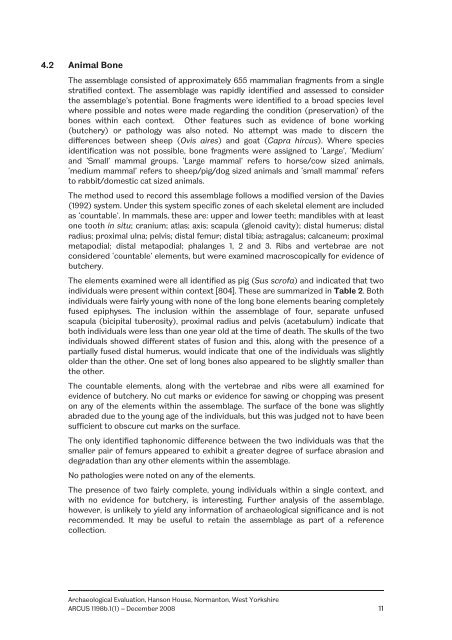Archaeological Evaluation at Hanson House, Normanton, West ...
Archaeological Evaluation at Hanson House, Normanton, West ...
Archaeological Evaluation at Hanson House, Normanton, West ...
Create successful ePaper yourself
Turn your PDF publications into a flip-book with our unique Google optimized e-Paper software.
4.2 Animal Bone<br />
The assemblage consisted of approxim<strong>at</strong>ely 655 mammalian fragments from a single<br />
str<strong>at</strong>ified context. The assemblage was rapidly identified and assessed to consider<br />
the assemblage’s potential. Bone fragments were identified to a broad species level<br />
where possible and notes were made regarding the condition (preserv<strong>at</strong>ion) of the<br />
bones within each context. Other fe<strong>at</strong>ures such as evidence of bone working<br />
(butchery) or p<strong>at</strong>hology was also noted. No <strong>at</strong>tempt was made to discern the<br />
differences between sheep (Ovis aires) and go<strong>at</strong> (Capra hircus). Where species<br />
identific<strong>at</strong>ion was not possible, bone fragments were assigned to ‘Large’, ‘Medium’<br />
and ‘Small’ mammal groups. ‘Large mammal’ refers to horse/cow sized animals,<br />
‘medium mammal’ refers to sheep/pig/dog sized animals and ‘small mammal’ refers<br />
to rabbit/domestic c<strong>at</strong> sized animals.<br />
The method used to record this assemblage follows a modified version of the Davies<br />
(1992) system. Under this system specific zones of each skeletal element are included<br />
as ‘countable’. In mammals, these are: upper and lower teeth; mandibles with <strong>at</strong> least<br />
one tooth in situ; cranium; <strong>at</strong>las; axis; scapula (glenoid cavity); distal humerus; distal<br />
radius; proximal ulna; pelvis; distal femur; distal tibia; astragalus; calcaneum; proximal<br />
metapodial; distal metapodial; phalanges 1, 2 and 3. Ribs and vertebrae are not<br />
considered ‘countable’ elements, but were examined macroscopically for evidence of<br />
butchery.<br />
The elements examined were all identified as pig (Sus scrofa) and indic<strong>at</strong>ed th<strong>at</strong> two<br />
individuals were present within context [804]. These are summarized in Table 2. Both<br />
individuals were fairly young with none of the long bone elements bearing completely<br />
fused epiphyses. The inclusion within the assemblage of four, separ<strong>at</strong>e unfused<br />
scapula (bicipital tuberosity), proximal radius and pelvis (acetabulum) indic<strong>at</strong>e th<strong>at</strong><br />
both individuals were less than one year old <strong>at</strong> the time of de<strong>at</strong>h. The skulls of the two<br />
individuals showed different st<strong>at</strong>es of fusion and this, along with the presence of a<br />
partially fused distal humerus, would indic<strong>at</strong>e th<strong>at</strong> one of the individuals was slightly<br />
older than the other. One set of long bones also appeared to be slightly smaller than<br />
the other.<br />
The countable elements, along with the vertebrae and ribs were all examined for<br />
evidence of butchery. No cut marks or evidence for sawing or chopping was present<br />
on any of the elements within the assemblage. The surface of the bone was slightly<br />
abraded due to the young age of the individuals, but this was judged not to have been<br />
sufficient to obscure cut marks on the surface.<br />
The only identified taphonomic difference between the two individuals was th<strong>at</strong> the<br />
smaller pair of femurs appeared to exhibit a gre<strong>at</strong>er degree of surface abrasion and<br />
degrad<strong>at</strong>ion than any other elements within the assemblage.<br />
No p<strong>at</strong>hologies were noted on any of the elements.<br />
The presence of two fairly complete, young individuals within a single context, and<br />
with no evidence for butchery, is interesting. Further analysis of the assemblage,<br />
however, is unlikely to yield any inform<strong>at</strong>ion of archaeological significance and is not<br />
recommended. It may be useful to retain the assemblage as part of a reference<br />
collection.<br />
<strong>Archaeological</strong> <strong>Evalu<strong>at</strong>ion</strong>, <strong>Hanson</strong> <strong>House</strong>, <strong>Normanton</strong>, <strong>West</strong> Yorkshire<br />
ARCUS 1198b.1(1) – December 2008 11

















